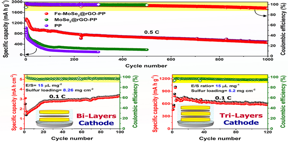Home > Press > Modulating MoSe2 functional plane via doping-defect engineering strategy to develop conductive and electrocatalytic mediators in Li-S batteries
 |
| Fe-MoSe2@rGO provides a promising avenue for producing a developed separator function for practical high-energy-density Li-S batteries. Fe-MoSe2@rGO-PP exhibits excellent cycling stability under lean E/S ratios and high sulfur loading. CREDIT Journal of Energy Chemistry |
Abstract:
The lithium–sulfur (Li–S) battery is considered a promising and efficient energy storage system because of its high energy density (2600 Wh kg-1) and low sulfur material cost. However, numerous obstacles to the practical implementation of Li–S batteries remain, including low sulfur conductivity, the shuttle effect, and the requirement for an adequate volume change (80%) of sulfur during charging and discharging operations, which have limited the applicability of Li–S batteries.
Modulating MoSe2 functional plane via doping-defect engineering strategy to develop conductive and electrocatalytic mediators in Li-S batteries
Dalian, China | Posted on September 23rd, 2022Transition metal chalcogenides (TMDs), such as molybdenum diselenide (MoSe2), have received attention as a viable method for accelerating sulfur redox processes. However, the limited number of active sites in MoSe2 considerably reduces their overall electrocatalytic performance. Metal doping into MoSe2 can improve the electronic conductivity of MoSe2 and generate defects, creating numerous reactive sites for catalytic reactions. Moreover, polysulfide transformation in the Li–S system can be improved through defect engineering, which can alter the physicochemical and electronic structure to enhance the adsorption and catalytic properties of a material.
Recently, Yutao Dong and Jianmin Zhang (corresponding authors), Mohammed A. Al-Tahan (first author), and others published a manuscript titled “Modulating of MoSe2 functional plane via doping-defect engineering strategy for the development of conductive and electrocatalytic mediators in Li-S batteries” in the Journal of Energy Chemistry.
The authors demonstrate that introducing iron exposes more active selenium edge sites in MoSe2, which can selectively adsorb more lithium polysulfides (LiPSs) to minimize the shuttle effect. Moreover, the conductive feature of rGO improves the cell's electrical conductivity and promotes the adsorption of polysulfides via chemical bonding with the functional group of rGO. Therefore, using the nanohybrid as a functional plane offers the advantages of high conductivity and effective LiPS adsorption.
####
For more information, please click here
Contacts:
Xiaoluan Wei
Dalian Institute of Chemical Physics, Chinese Academy Sciences
Office: 86-041-184-379-021
Copyright © Dalian Institute of Chemical Physics, Chinese Academy Sciences
If you have a comment, please Contact us.Issuers of news releases, not 7th Wave, Inc. or Nanotechnology Now, are solely responsible for the accuracy of the content.
| Related Links |
| Related News Press |
News and information
![]() Researchers develop molecular qubits that communicate at telecom frequencies October 3rd, 2025
Researchers develop molecular qubits that communicate at telecom frequencies October 3rd, 2025
![]() Next-generation quantum communication October 3rd, 2025
Next-generation quantum communication October 3rd, 2025
![]() "Nanoreactor" cage uses visible light for catalytic and ultra-selective cross-cycloadditions October 3rd, 2025
"Nanoreactor" cage uses visible light for catalytic and ultra-selective cross-cycloadditions October 3rd, 2025
Possible Futures
![]() Spinel-type sulfide semiconductors to operate the next-generation LEDs and solar cells For solar-cell absorbers and green-LED source October 3rd, 2025
Spinel-type sulfide semiconductors to operate the next-generation LEDs and solar cells For solar-cell absorbers and green-LED source October 3rd, 2025
Discoveries
![]() Researchers develop molecular qubits that communicate at telecom frequencies October 3rd, 2025
Researchers develop molecular qubits that communicate at telecom frequencies October 3rd, 2025
![]() Next-generation quantum communication October 3rd, 2025
Next-generation quantum communication October 3rd, 2025
![]() "Nanoreactor" cage uses visible light for catalytic and ultra-selective cross-cycloadditions October 3rd, 2025
"Nanoreactor" cage uses visible light for catalytic and ultra-selective cross-cycloadditions October 3rd, 2025
Announcements
![]() Rice membrane extracts lithium from brines with greater speed, less waste October 3rd, 2025
Rice membrane extracts lithium from brines with greater speed, less waste October 3rd, 2025
![]() Researchers develop molecular qubits that communicate at telecom frequencies October 3rd, 2025
Researchers develop molecular qubits that communicate at telecom frequencies October 3rd, 2025
![]() Next-generation quantum communication October 3rd, 2025
Next-generation quantum communication October 3rd, 2025
![]() "Nanoreactor" cage uses visible light for catalytic and ultra-selective cross-cycloadditions October 3rd, 2025
"Nanoreactor" cage uses visible light for catalytic and ultra-selective cross-cycloadditions October 3rd, 2025
Interviews/Book Reviews/Essays/Reports/Podcasts/Journals/White papers/Posters
![]() Spinel-type sulfide semiconductors to operate the next-generation LEDs and solar cells For solar-cell absorbers and green-LED source October 3rd, 2025
Spinel-type sulfide semiconductors to operate the next-generation LEDs and solar cells For solar-cell absorbers and green-LED source October 3rd, 2025
![]() Rice membrane extracts lithium from brines with greater speed, less waste October 3rd, 2025
Rice membrane extracts lithium from brines with greater speed, less waste October 3rd, 2025
Battery Technology/Capacitors/Generators/Piezoelectrics/Thermoelectrics/Energy storage
![]() Rice membrane extracts lithium from brines with greater speed, less waste October 3rd, 2025
Rice membrane extracts lithium from brines with greater speed, less waste October 3rd, 2025
![]() Sensors innovations for smart lithium-based batteries: advancements, opportunities, and potential challenges August 8th, 2025
Sensors innovations for smart lithium-based batteries: advancements, opportunities, and potential challenges August 8th, 2025
![]() Deciphering local microstrain-induced optimization of asymmetric Fe single atomic sites for efficient oxygen reduction August 8th, 2025
Deciphering local microstrain-induced optimization of asymmetric Fe single atomic sites for efficient oxygen reduction August 8th, 2025
|
|
||
|
|
||
| The latest news from around the world, FREE | ||
|
|
||
|
|
||
| Premium Products | ||
|
|
||
|
Only the news you want to read!
Learn More |
||
|
|
||
|
Full-service, expert consulting
Learn More |
||
|
|
||








